SAP Production Planning- SAP PP Tutorial
Category: SAP S/4HANA Logistics Posted:Jun 16, 2020 By: Robert
SAP Production Planning is one of the most crucial modules of SAP. It handles procedures such as material planning, capacity planning, production planning, goods movement, and billing of the goods. It is the procedure of fulfilling the demand and production capability of a company. SAP Production Planning aids an organization schedule the procurement and manufacturing of products. It is fully integrated with other modules of SAP such as SAP Material Management, Quality Management, FICO, and Plant Maintenance.
In this SAP PP Tutorial, you will learn about SAP Production Planning which is one of the most important modules of SAP. In this SAP PP tutorial, I will cover the following topics which are mentioned below.
- Sub-modules of SAP PP
- Organizational Structure of SAP PP
- Integration of SAP PP with Other Modules
1. SAP MM and SAP PP
2. SAP SD and SAP PP
3. SAP FICO and SAP PP
4. SAP Project System and SAP PP
5. SAP Quality Management and SAP PP
- Master Data
- Demand Management
- Production Planning Cycle
- Conclusion of SAP PP Module
Sub-modules of SAP Production Planning (PP)
In this SAP PP tutorial, I will discuss two different production industry within the SAP PP module which are:
- Discrete Production
- Repetitive Production
- Discrete Production: Discrete Production is an industry where the production of materials keeps on changing according to the order, and their costs are also calculated accordingly.
- Repetitive Production: Repetitive Production is an industry where the produced materials do not change for a long period of time. Products are produced according to the total quantity as well as not according to the individual orders.
Checkout the Article- A Completes Guide of SAP Simple Logistics
Organizational Structure of SAP PP
In this SAP PP Tutorial, we will learn about an organization that is created of numerous levels and several units. These units follow a regular hierarchy. This SAP PP tutorial will handle each of the units that has a unique feature that constitutes together to explain the structure of an organization. The organizational structure of SAP Production Planning comprises the location of manufacturing plants as well as the location of storage areas within the plant.
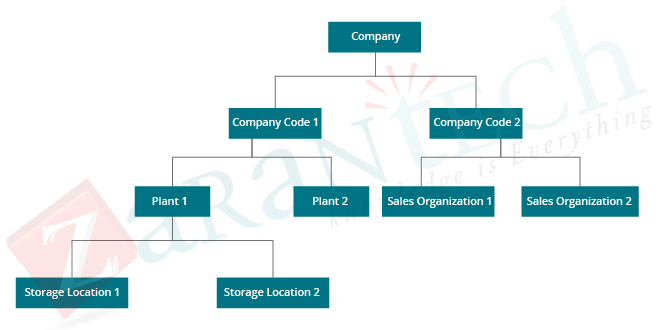
- Company code: A company code is the smallest unit in a company that comes under the client’s level. It has an independent accounting unit that maintains its own Profit, Loss, and Balance Sheet.
- Plant: A plant is a unit within a business that is responsible for the production of goods and making them available for the company. A Plant unit contains a manufacturing facility and a warehouse.
- Storage location: A Storage Location is a unit within an organization that is utilized to keep material stock and goods available in a plant. A plant can have several storage locations where all the data related to the storage area are saved.
Integration of SAP PP with Other Modules
In this SAP PP Tutorial, let’s learn about the SAP PP Integration with various modules of SAP to perform Production Planning and manage the activities associated with production.
Following are the connections between SAP PP and other modules:
1.SAP MM and SAP PP
- The connection between SAP MM and SAP PP handle auto goods receipt and the movement of goods.
- It also handles the creation of planning/booking for the production order.
- This connection is used to raise purchase orders with MRP run.
- It aids in handling quotations from various vendors and after that select the appropriate vendor.
2. SAP SD and SAP PP
- Their relationship is used to maintain the organization updated on the availability of the material.
- These connection aids perform requirement types and MRP runs.
- It is used to manage the procedure and expense of materials elements.
3. SAP FICO and SAP PP
- Their relationship maintains the price update in Material Master Data.
- It is used to define the activity to enter the cost center.
- It is additionally used to assign the activity type to the work center.
- It is utilized to execute cost estimation.
- It is utilized to control the Cost of Production.
- It is used for posting account activities that relate to the material request, goods movement, and so on.
4. SAP Task System and SAP PP
- Their connection is used to assign planning activities to WBS in the project.
- It is used for running Material Requirement Planning at the project level.
- It is used to connect the component to the network that is intended at the plant level and is reserved as plant stock.
5. SAP Quality Monitoring as well as SAP PP
- Their connection is used to inspect Type 03 for repetitive and discrete manufacturing.
- It is used to inspect Type 04 for both repetitive and discrete manufacturing.
Master Data
This SAP PP tutorial will help you learn about the Master data that consists of the complete items in the SAP PP module. SAP PP Module comprises five master data. The following are the five master data of SAP PP module:
- Material Master
- Work Center
- Bill of Materials
- Routing
- Product Version
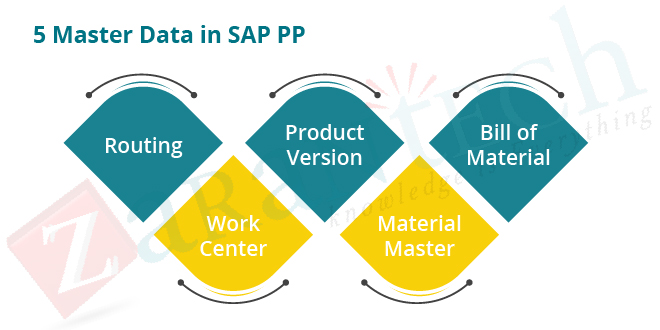
1.Material master: All materials having common characteristics are set up together, and they are allocated to a material type. It helps differentiate the materials and handle them methodically. Material Master is utilized in storing various types of materials, such as raw material and finished products. It determines a product on the basis of goods issue or goods receipt, purchase material, MRP, and also production confirmation.
2. Work center: The Work Center comprises the master data which is related to the production operations of a product. Following are the Production Operations that occur within a work center of a company:
- Capacity planning: Capacity Planning is utilized to evaluate the requirements for the current and future capability of products stored within the work center.
- Production costing: Production Costing is utilized to calculate the cost of a product according to its respective formulas.
- Scheduling: Operations in production orders are scheduled as per operating times in the work center.
3. Bill of Materials: The Bill of Materials is a complete list of materials according to the quantity that is required for the production of a product. It is used for the material requirement planning for a product.
Also, you can create superbills to handle the list of all essential materials required to produce various variations of a product.
Characteristics of Bills of Materials:
- Either numerous levels or a single level of bill of materials can be created.
- The type of bill of materials depends on the production technique, size, and validity days.
- 99 bills of materials can be created based on the material type.
- Bill of materials can be utilized for the material available in the SAP PP module, and equipment bill of materials can be used in the SAP Plant Maintenance Module.
4. Routing: There are several activities or approaches that are involved in the production of a product. Routing is nothing but a series of methods or activities that are predefined for the production. These activities or methods are carried out in the work center. Routing is also used to calculate the labor time, machine time, and production cost.
Features of Routing are as follows:
- It is mandatory to first define the work center before creating routing.
- A single routing group can be used for multiple materials.
- It is used for the scheduling of raw and finished products.
- It is utilized to evaluate the cost of operation for a finished product.
5. Product version: The Product Version is the successor version of an old product with new features acquired into it. The product version is developed according to market demand and its changing trends. It is developed using routing data and bill of products.
There can be several variations of a product according to the Demand, Time, and various manufacturing procedures for production.
Demand Management
We will discuss demand management which is used to estimate the delivery dates and requirements for a product. Under the SAP PP module, demand management uses Planned Independent Requirements (PIRs) to get their input for product planning. In Demand Management, different planning strategies are used to identify various planning approaches.
Following are two planning techniques:
- Make to stock
- Make to order
- Make to stock: Make to Stock is used to examine the future demand for a product and accordingly produce the product without having the actual sales order.
- Make to order: The Make to Order strategy is used to produce a product just after getting the order for a particular product. As quickly as the customer places an order, the production of a product gets started.
Go through our SAP S/4HANA Simple Logistics Interview Questions to crack the Interviews.
Production Planning Cycle
In the SAP PP module, Production Planning includes several levels that are required to evaluate the product and execute the production of it. Production planning is carried out on the basis of the sales chart of a product. The sales chart gives an overview of the demand for the product that assists an organization analyze and make its decisions accordingly. After the evaluation of the demand and the need for a product, the organization should start its production in order to meet its customer requirements. The Production of a product consists of numerous levels. They are as follows:
- Planned independent requirement (PIR).
- MPS/MRP Running.
- Capacity Planning and Capacity Leveling.
- Production Orders.
- Product Confirmation.
1. Auto Goods Receipt.
2. Auto Goods Issue.
- Production Order Closed/Settled.
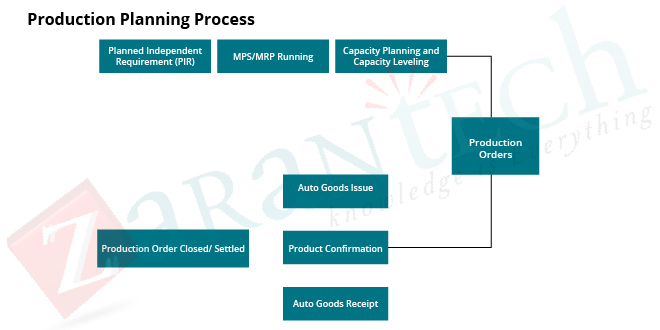
- Planned Independent Requirement(PIR): Planned Independent Requirement (PIR) is utilized to perform the demand management in an SAP PP component. The planned independent requirement is used to provide the input for production planning. Planning an independent requirement is used to define the planning approach that has actually been discussed above in demand management.
- MPS/MRP Running: MPS/MRP running is a system that is used to fill the gap between the supply and demand of a product in a timely manner. The issue, as well as receipt, becomes part of the MRP element. The issue is an MRP Element that includes order reservations, sales orders, stock transfer orders, PIRs, etc. and the receipt is an MRP element that is utilized to generate the receipt against production orders, purchase requisition, etc
- Capacity Planning and Capacity Leveling: Capacity Planning is used to maintain the balance of the workload at the work center. It is used to calculate the production capacity of a product according to the needs of the product and its availability. Capacity leveling is used to evaluate the production planning process. Capacity Leveling is carried out using the thorough planning capacity as well as its requirements in the future.
- Production orders: Production Orders consist of information related to the material required for production, location of the plant where the production is executed, date and time of produced products, and the number of goods that will be needed for the production of a product. It is also used to specify the components as well as operational sequences that are used for production.
- Product confirmation: After receiving the production order, the availability of materials is checked with the inventory system, and then the production begins. The production confirmation is done using the following steps:
- Auto goods receipt: Goods Receipts are generated automatically when the material is produced based on the production order and get stored at the particular storage locations.
- Auto goods issue: Goods Issue happens when an order comes for production and when the needed material for the production is consumed according to the production order. After the consumption of the required material, the system reduces the elements in the inventory system.
- Production order closed/settled: The production order gets closed entirely when the product is provided to the respective organization/person. It also gets closed in situations where you do not need any more production of the product, therefore, in such situations, the product gets technically completed.
Checkout the Article- What Is Logistics? User Should Know About the Logistics Management
Final Thought
This SAP PP module is in huge demand as all businesses need the SAP PP module to manage the demand and requirements of their product in an efficient manner. The SAP PP module helps companies remain updated about the demand and quantity of their products.
That’s all for today. Check out ZaranTech’s SAP S4 HANA Logistics Online Course to get ahead in your career!
Watch SAP S4 HANA Logistics Full Course For Beginners:


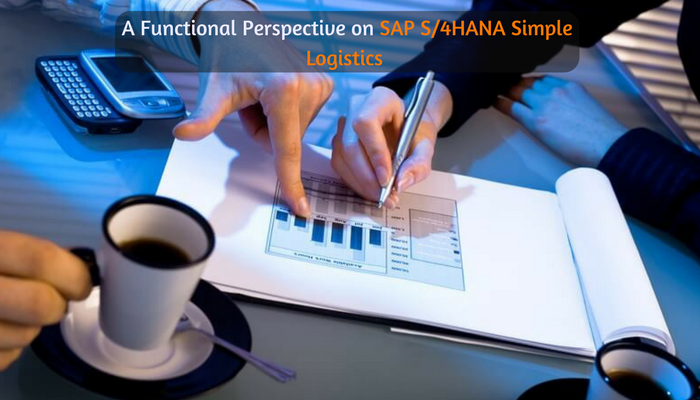
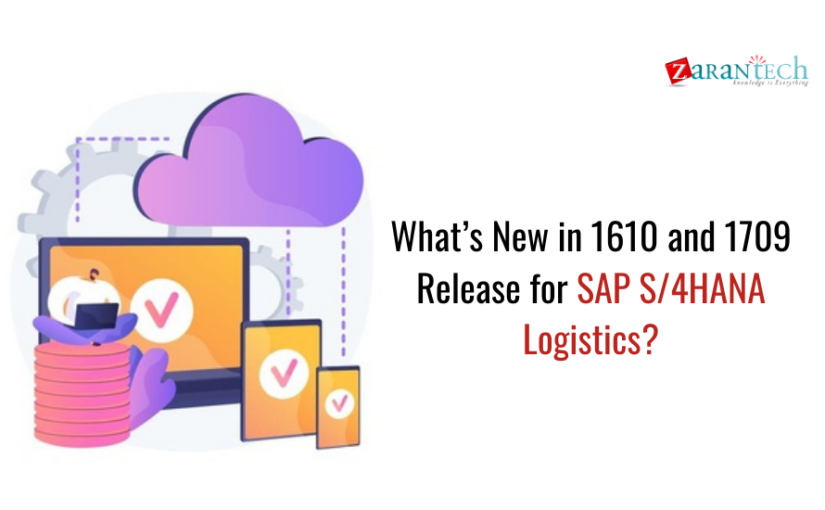
 99999999 (Toll Free)
99999999 (Toll Free)  +91 9999999
+91 9999999